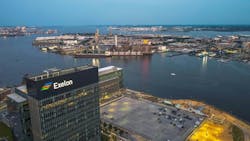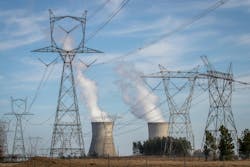Powering the Future: Addressing Rising Energy Demand and the Role of Data Centers and Nuclear Energy
Key Highlights
- Industry leaders emphasized the critical need for reinvention and collaboration to meet increasing energy demands and address the energy trilemma.
- Data centers are projected to consume over 7% of US electricity by 2028, requiring diverse energy sources including nuclear and natural gas to meet this surge.
- Significant investments, such as Exelon's $38 billion grid upgrade plan, aim to enhance reliability and accommodate new load growth driven by AI and data centers.
- Advancements in nuclear power, including the successful deployment of new units at Vogtle, are seen as vital for a sustainable and reliable energy future.
- Utilities are balancing affordability and sustainability, prioritizing customer needs and transparent communication to foster trust and support for energy initiatives.
Of the many topics explored at Accenture’s International Utilities and Energy Conference (IUEC) 2025, whether it was artificial intelligence, nuclear energy or data centers, attendees viewed each one in terms of whether it would help or hinder the over-arching goal of meeting soaring energy demand forecasts.
IUEC is an invitation-only event for senior executives across all energy sectors, with representation from heavy and light industry also. Convened in Washington, D.C., there was much talk about how to deliver reliable and clean electricity to customers who are concerned about rising costs of electricity as well as rising costs in almost everything else.
Scott Tinkler, Global Utilities Industry Lead, Accenture, highlightedthe “trilemma” of energy affordability, reliability and sustainability.
“Reinvention is no longer optional,” Tinkler said during an opening plenary session at IUEC. He added that global electricity demand has exceeded 4% for the first time since the 2000s. This demand growth is driven by data centers and the artificial intelligence industry.
To address this trilemma, Calvin Butler, CEO of Exelon as well as Chair of the Edison Electric Institute (EEI), said his utility is setting aside $38 billion over the next 10 years for power grid improvements.
“Our customers have very different needs today than they did yesterday, and they have different expectations of us too,” Butler said. “Our customers need to be on this journey with us.”
Levi Patterson, Director of Energy, Science and AI Infrastructure Policy at NVIDIA, took an optimistic view of the large growth forecast for energy demand.
“When I started my career, I was a nuclear engineer in the world of the Nuclear Renaissance that never really happened. If we had had this demand growth that we are seeing right now, maybe more would have happened. This demand surge could allow us to bring some cool new technologies to market faster than we ordinarily would have,” Patterson said.
Butler agreed with demand being a powerful driver for needed change, saying there was 16 GW of anticipated new load growth in Exelon’s home state of Illinois alone. He added to his prepared remarks in a one-on-one interview with T&D World afterward.
“This is the first time we've experienced this level of demand, probably since the ‘60s. You look at the advent of air conditioning, right? I mean, we're talking that long. So, this demand curve forces us to look at things differently, but it is also driving new technologies,” Butler told T&D World.
Of his work at EEI, Butler said he would like to foster greater collaboration among energy stakeholders to help build the infrastructure upgrades and retrofits needed to address all the demands on the energy sector.
“Collaboration is going to be the only way we achieve our goals, where the federal government steps in and removes barriers to building new generation. The government also understands that these regional authorities need to free up pipeline to get new projects going. I mean, it takes us almost 6 to 7 years to do siting to build new transmission lines. We are not going to achieve our goal of meeting this energy dominance or energy security with that type of regulation bogging down the system,” Butler said.
Speakers also frequently mentioned the human element in solving these issues. Maryland Gov. Wes Moore took the stage to say the economy needs electricity, and that the electricity industry needs the best people it can find to keep the economy growing.
“I knew that I could sum up what we needed to do in the State of Maryland in one word, and that was growth. We needed to make sure that our economy was growing. We needed to make sure that our economy was more competitive, and we needed to make sure that that growth was going to be inclusive growth, And the thing that I always felt, and why this conversation around utilities and power became so important, was something had to power the growth. Something had to be the engine behind what we were getting going,” Moore said.
Moore went on to say that diversity, equity and inclusion initiatives are a solid path to elevating more people to do the kind of skilled work the power grid requires. I asked Butler, who introduced Moore, if he agreed with this approach.
“Yes. I think the industry has done a wonderful job in making itself a place where people can have family sustaining careers. We've worked with labor in tandem to ensure that we have talent coming in through the pipeline. Butler said. “I believe what makes Exelon as strong as we are is that we represent the communities that we serve. And when you look at us, we have not only the most reliable utility in the nation in ComEd, but also the third, fourth and eighth most reliable utilities in the nation too, in Pepco Holdings, BGE and PECO, meaning we have four out of the top eight.”
Data Centers
There were entire panels devoted to the issue of demand from data centers. In its recent studies, Accenture found power consumption by data centers could surge to over 7% of total US electricity by 2028 and increase to 16-23% by 2033. Further, Accenture’s report, “Powering the future of US data centers,” released in March 2025, says that renewable sources alone will not be enough to meet this demand and other energy supply options like nuclear and natural gas must be incorporated into the generation mix.
David Velazquez, former President and CEO of PECO, an Exelon utility, said the growth could be called an “explosion.”
“How do we meet demand at speed? If you’re planning a data center, you’ll need to know what the sites are. We talk to hyperscalers and big customers about this. It’s a complex problem to solve because of the scale of these hyperscalers,” he said. “Our largest customers used to be refineries, but now we are talking about hyperscalers that demand gigawatts of energy. Fortunately, they don’t come online at full scale. They ramp up.”
James Mazurek, Accenture’s Strategy lead for Utilities in North America, said Accenture looked at the needs of data centers and hyperscalers to determine what their drivers are. Electricity supply, labor availability, siting, GPU availability, maintenance and property taxes are all important considerations.
“The wild card in all of this is when a state’s executive leader just declares they want to drive data center activity in our jurisdiction through attractive incentives. That happened down in Tennessee a few months ago,” Mazurek said, adding that Virginia, Texas and Illinois are each major hotspots for data center growth and expansion.
Power Generation
Accenture’s research on load growth found that energy sources such as gas-fired power and nuclear power from small modular reactors will play a key role in the energy mix going forward.
“There's an abundance of supply in Texas right now, and the same holds true in Illinois and some other jurisdictions as well. This gets back into natural gas again as well. Data centers generally require firm, dispatchable generation. 24/7. Texas has an abundance of that,” Mazurek said, adding that most of Texas operating as its own power grid is another benefit for hyperscalers.
States that were retiring coal plants, like New York for example, are also seeing crypto mining operations move in where the coal plant infrastructure was still in place — leading to massive new load being added in an area where a power generation assets once sat, Mazurek said.
Maria G. Korsnick, President and CEO of the Nuclear Energy Institute (NEI), and Julie Kozeracki, Director of Strategy for the US Department of Energy Loan Programs Office, held a talk called “Nuclear’s New Groove,” where both women said the successful installation of two new nuclear units at Southern Co.’s Plant Vogtle represented breaking down a barrier to new nuclear power construction.
“There’s been a lot of interest and attention on SMRs, but, as you heard the president say, we need the big ones too,” Kozeracki said. “The folks at Southern ran thru a wall for us and completed Vogtle 3 and 4 and now the Westinghouse AP1000 is up and running.”
As for the underestimates of project construction costs and timelines, Kozeracki said these were to be expected of the two first new nuclear units to be constructed in the U.S. in the last 30 years, and will not happen again.
“If you look at the lessons of Vogtle, a lot of these were cost underestimations, and many of those will not be repeated. A lot of analysis shows that a $14 billion project was never possible,” she said, adding that the Westinghouse bankruptcy during the design phase and the COVID restrictions were compounding factors.
“You can’t not build something for 35, 40 years and then come right out of the gate and have it go completely fine. We hadn’t been doing it for years. We should see this as a story of American grit and perseverance,” Korsnick said. “We now have a plan and a proven design to go on.”
Increasing load growth forecasts will drive SMRs to be adopted in the US, Korsnick said.
“The load growth forecast for the last 40 years has been kind of boring. To have a forecast like this is amazing but also challenging. If companies end up building SMRs, it will probably be a lot of SMRs,” she said.
Affordable Power
At an opening plenary session, Exelon CEO Butler said he sometimes gets in trouble for a quote of his saying that clean energy may need to take a backseat to providing cheaper energy for consumers.
“My CEOs say ‘But Calvin, we are committed to clean.’ I said, ‘Yes, but our customers need affordability right now and we have to meet them where they are at,”’ Butler told attendees from the stage.
In a later interview, I asked him to explain this in greater detail. He says Exelon utilities do try to deliver both affordability and sustainability in every jurisdiction, and the company’s constituent utilities are on paths to meeting their climate goals.
“Clean energy is a priority. When you look at our own path to clean, we are on track to be net zero business-driven emissions by 2050,” Butler said. “What I was referring to is that because of the inflationary times that we're in, our customers are feeling that pain and they no longer lead with clean. They lead with affordability. So when I say it's taking a back burner, it means that is not the first conversation we have. It's ‘Calvin, how can you help me pay my bills?’”
In these times, utilities should also work to make sure customers understand what their electricity bills pay for, he said, adding that it is up to utilities to tell them.
“As difficult as it is for people to pay more, people don't mind paying for what they feel they're getting value for. You know, your iPhone, a lot of people get the latest model and it costs them more, but they see value in what those upgrades are. What we have to do better as an industry is articulate the value that we bring,” he said.
About the Author
Jeff Postelwait
Managing Editor
Jeff Postelwait is a writer and editor with a background in newspapers and online editing who has been writing about the electric utility industry since 2008. Jeff is senior editor for T&D World magazine and sits on the advisory board of the T&D World Conference and Exhibition. Utility Products, Power Engineering, Powergrid International and Electric Light & Power are some of the other publications in which Jeff's work has been featured. Jeff received his degree in journalism news editing from Oklahoma State University and currently operates out of Oregon.


